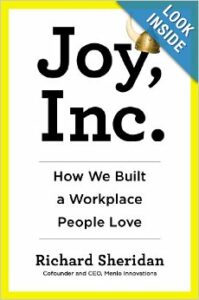 Joy, Inc.: How We Built A Workplace People Love
Joy, Inc.: How We Built A Workplace People Love
by Richard Sheridan
Portfolio/Penguin, 2013
This book is by Richard Sheridan, who is the CEO of Menlo Innovations, a software company in Ann Arbor, Michigan. They’ve been covered by Inc., NPR and others, partly for their radical ideas of (a) having all their software programmers work together in one big room (no offices, not even cubes), and (b) actually having two programmers per one computer. Yes, they believe in collaboration so strongly that they have people write code in pairs, sharing one mouse/keyboard. And they switch their pairs on a weekly basis.
Those are certainly notable innovations, and I see why they get the attention, but there are more important messages in the book:
Learning. One of the reasons they switch their programming pairs constantly is to ensure that everyone is learning. All the time. Quickly. Yes, this means you have to update your new pair on what you were working on last week. Is that a waste of time? Not according to Sheridan, who realizes that forcing yourself to recap what’s been going on is actually a great discipline. It actually helps you see the forest from the trees. And they don’t just learn internally. They learn a TON about their customers. They go out and hang out with the end users of the software to find out what they’re like and how they operate. None of them ends up being THE expert on java or any other interface. According to Sheridan: “We believe that relying on deep expertise stifles innovation. We may need to learn a new programming language or software tool for a client’s project; our organization is built to handle this.”
Decentralization. When they are hiring, they start with a group interview of maybe 30 candidates (there are only 50 people in the whole organization). They have them do simulated work in the interview–in pairs, just like they would if they got hired. Except in the interview they have an observer (one of the current Menlo staff). That means 15 staff members are involved in the process. They are not the senior managers. They are not the supervisors. They are 15 people on the team. And they get to vote up or down the candidates, not the boss. That’s decentralization. By the way, if candidates make it past the first group interview, they are invited in to work (paid) for one day. If that day goes well, they come in for a three-week contract. If THAT goes well, then they are hired. It’s really hard to tell if someone is a good fit for your culture just by interviewing them.
Experimentation. Sheridan makes a key distinction between a culture where people “feel safe” versus one where they are focused on “being safe.” In a culture where people actually feel safe, they will run experiments, they will learn from their mistakes, they will not need to ask permission. All of this enables learning (see above). In a “being safe” culture, people only run experiments that they know are going to succeed. Just to be clear: those are not experiments. If your experiments don’t fail sometimes, then you’re not doing them right. Or, as Sheridan points out, if the rate of failure of your experiments starts to decline, then perhaps fear has gained some ground in your culture, and that needs to be addressed.
Do those three concepts sound familiar? They are 3 of the 12 principles we identify in Humanize, which is one reason Maddie and I have booked a trip to Ann Arbor in May to do a tour of Menlo and talk to some of their team members. And there’s more in the book, too. The description of their project management system (which uses mostly index cards posted on a cork-board wall) is very interesting, and I also liked how their clients are in their offices on a weekly basis, helping the work prioritize what gets worked on (I could have had a paragraph above on collaboration, another Humanize principle).
This book is a MUST READ, particularly if you are interested at all in organizational culture, but I think it’s a great resource for any leader (at any level).
